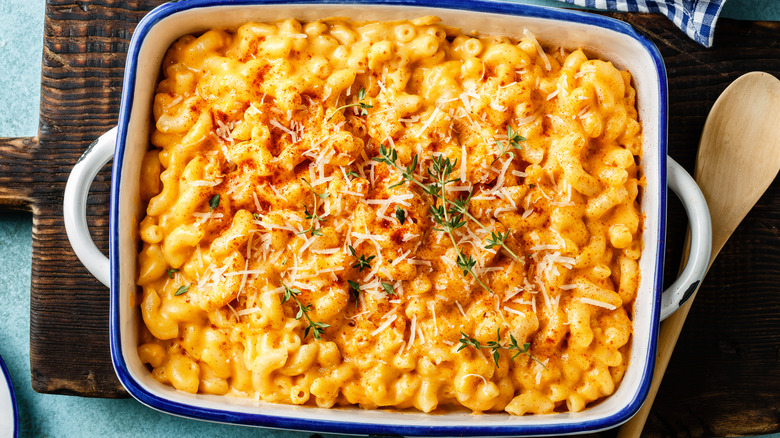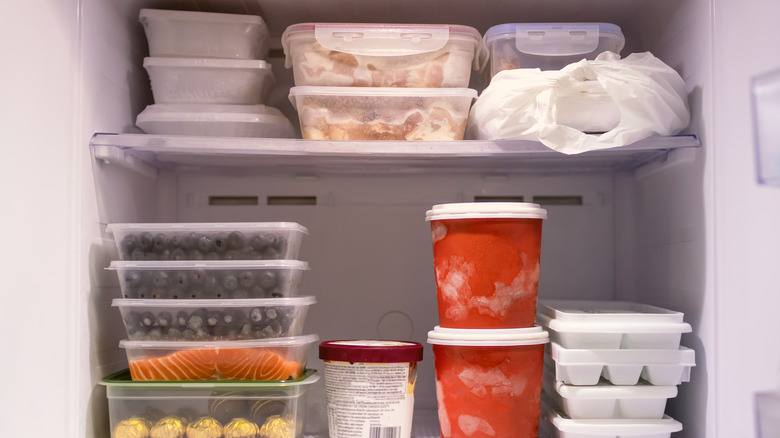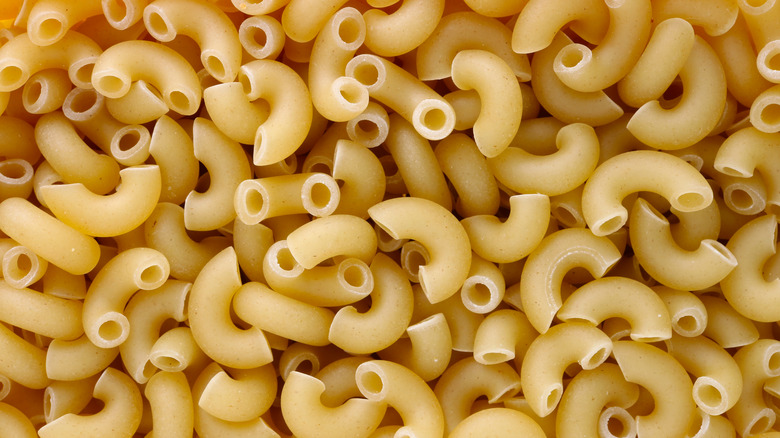Why You Should Undercook Noodles For Batch Mac And Cheese
Making meals ahead of time and freezing them is the ultimate gift to yourself. No matter if you're feeding a party of one or a table full of family and friends, your advance cooking project promises an easy evening in the near future. And a delicious evening, at that.
A classic freezer meal is mac and cheese. One look at the many packaged options at the grocery store, and it's clear this dish has a hold on busy eaters. But, for many home cooks, store-bought just doesn't cut it. Maybe you're choosing a thriftier approach by making your own or you simply enjoy your recipe better — whatever the reason, homemade batches are delicious and hold up after a deep freeze.
One trick that will make yours even better: Undercook the macaroni. Noodles are famously prone to sogginess, even when you're not freezing them. So, set yourself up for success by pulling the pasta from the pot about two minutes earlier than the box recommends, which will provide a firm pasta ready for the journey to the freezer and, later, to the oven.
Preparing a freezer-friendly mac and cheese
In addition to super al dente pasta, the macaroni in macaroni and cheese can benefit from another couple of adjustments. If you're concerned about the sauce absorbing or evaporating, you can alter your recipe a smidge. When preparing the cheese and the noodles, make sure to let each component come to room temperature before you combine them to ensure the dish stays moist. We recommend using the sheet pan hack to quickly cool the starch down. If you're still struggling, use less pasta to limit absorption further.
Then, it's to bake or not to bake. Though some mac and cheese recipes call for a trip to the oven before freezing the meal, this move could undo your thoughtful pasta prep. The initial cooking, coupled with a future defrost and reheat, can leave you with beyond-tender noodles. If the soft texture works for you, or you're freezing leftovers, you'll still have a cheesy treat, but for a more toothsome bite, wait and only bake before eating.
The same rule applies for toppings like crispy breadcrumbs or shredded cheese. Prepare your toppings before baking, rather than before freezing. This sets you up for crunchier textures and plush melty cheese. After you've taken the dish out of the cold and let it safely defrost in the fridge, add your final elements to elevate this make-ahead meal.
The best noodles for the job
There are some ingredients that just don't belong in macaroni and cheese. But the creamy dish is otherwise a blank slate, ready for tasty additions like green chilis and bacon. Before you work on creative seasonings, however, make sure to choose your base pasta with care.
Experts have yet to pinpoint one brand or ingredient that makes a pasta freeze better than others, but they do agree that mac and cheese is no place for fresh noodles. Save that project for another day. Here, the pantry version will hold up better during the multi-step process. One twist you can try is buying "slow-dried" pastas, an increasingly popular choice among discerning eaters that costs slightly more than the regular stuff, because they have rougher exteriors that are arguably better at catching sauce.
As for the shape, there's no consensus whether an elbow or corkscrew shape freezes any better than spaghetti. However, short tubes and twisty spirals are two favorite silhouettes — particularly cavatappi, a twisty, hollow noodle on the longer side — for the heavy dish because they can stand up to thick sauces and grip onto the creamy filling. Boxed brands tend to use elbow or penne, which leads us to think those are perfectly good choices for home cooks.



